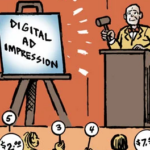 “Data-Driven Thinking” is written by members of the media community and contains fresh ideas on the digital revolution in media.
“Data-Driven Thinking” is written by members of the media community and contains fresh ideas on the digital revolution in media.
Today’s column is written by Jay Friedman, chief operating officer at Goodway Group.
Despite not having an ad-focused business model, Amazon keeps Sir Martin Sorrell up at night and is the most likely candidate to challenge Google’s and Facebook’s ad dominance.
It looked like it could have been Oath, but from a buyer’s perspective, those assets are neither aligned nor organized. Video teams aren’t integrated with display teams, and the various assets from the three portals are still quite disparate.
What about Oracle or Salesforce? No buying mechanisms.
Adobe? No proprietary data.
So, if the duopoly is to be challenged, it may start with Amazon. But does Amazon and its assets have the potential or legitimacy to pose a real threat?
Revenue
Barclays estimates Amazon’s 2016 ad revenue at $1.4 billion.
Facebook had $8.6 billion in Q4 2016 alone, and $26.9 billion for the year.
Google, wondering why there’s a gnat with an Amazon logo flying around its house, ended 2016 with ad revenue at around $79 billion.
OK, no challenge yet. In fact, it’s debatable if it’s even a duopoly.
Data
With the lion’s share of search ad revenue still going to Google, it remains the leader in intent data, not to mention Android, maps and all other assets combined. Alphabet owns so much data that there have been questions raised as to whether or not all of these assets should remain in one company.
The EU seems to think things aren’t right. While 55% of product searches begin on Amazon, Google clocked in at 28%, which still provides plenty of volume for building smart models. But Amazon’s share of product searches is gaining, and Google’s is abating. This one trend could be hugely impactful in the coming years to determine the balance of power and whether or not Amazon can successfully challenge Facebook and Google.
And not only does Amazon have the best product intent data around, it is making it extremely easy for traders to access it through its platform. Traders have instant access to target low-funnel, highly specific audience segments that are built from Amazon’s wealth of data.
Amazon also makes data onboarding and lookalike modeling effortless. When you upload first-party data, the segment is available immediately, versus other providers who can have longer wait times. Marketers can then build a lookalike model from that segment and have it available for use usually in less than 24 hours, again a relatively speedy turnaround.
Another data advantage Amazon gives its advertisers who are also sellers on amazon.com is rich insights into product shopping behavior via its platform reporting.
Let’s say you’re running a link-in campaign that drives users to an Amazon product page for protein bars, and you notice the vanilla flavor is not selling well. As a trader on the platform, you can take a look at what users are doing once they leave the vanilla flavor product page – are they buying chocolate instead? Are they going to a competitor’s page? Not only does this help to optimize the campaign, it helps to optimize an advertiser’s overall business strategy. These are powerful insights that only Amazon can deliver given its unique position.
Now, compare all of this to Facebook. The value of Facebook’s data is less easy to estimate. It knows if users are wowed by certain pictures and may like a movie, band or other cultural item. Facebook knows where users go each day, including the businesses at which they spend the most time. But Facebook is missing so much of the online shopping behavior the other two capture.
Google may still be the data king, but Amazon is a strong contender that brings plenty of value to almost any marketer.
Buying Technology
Facebook famously shuttered its demand-side platform (DSP) and supply-side platform (SSP). Marketers get limited information about ads bought through Facebook Audience Network, outside of facebook.com. Facebook has a strong mobile, on-property play, but the lack of off-property transparency, the lack of a DSP and its fully walled garden force Facebook to the rear of the group in buying technology.
Amazon’s DSP is newer and has not had the time to build out features that traders appreciate, such as bulk editing tools, bid factoring and a slick, fast UI. Traders also do not have the level of brand safety or viewability controls that you find in other DSPs, and while access to Amazon data segments is strong, access to non-Amazon segments is limited.
Google’s DoubleClick Bid Manager is powerful, possessing most all of the connections, integrations and inventory marketers need compared to Amazon and Facebook. But Amazon has a lot of promise.
‘X’ Factor
Here’s where things get interesting. Facebook owns Instagram, WhatsApp and Oculus, among others.
But Amazon owns an entire entertainment platform of music and video. Alexa is the leader in in-home automation technology. Amazon has post-office-verified addresses. Amazon also owns Prime Pantry, Fresh and (soon) Whole Foods, which offer a direct view into packaged goods the others don’t have. And let’s not forget Amazon’s cloud services, a major B2B play which only Google can rival with its productized office suite.
Google has some significant advantages as well. Google owns mapping and driving directions, in addition to 64% of the smartphone OS market share and Chrome, which is at roughly 60% market share. Chrome and Android are so prevalent and pervasive that they could feasibly stand on their own.
Determination And Ruthlessness
There are two other important considerations: determination and ruthlessness.
Case in point: In order to advertise on Amazon, you must be an approved advertiser and not a competitor. I know of a popular grocer that once advertised on Amazon. Right after the Whole Foods acquisition was announced, Amazon informed the company that it had to take the campaign down by the end of the week, end of story.
Amazon wouldn’t allow a competing grocer to advertise on its platform at the risk of losing business from its own food properties. This is similar to Amazon’s business strategy overall: Play to win in the long term at the expense of short-term profits. If Amazon has true ad tech ambitions, it’ll need to be a platform and not a referee.
Google and Facebook should be on alert. There may be a third contender in the ring soon.
Follow Jay Friedman (@jaymfriedman) and AdExchanger (@adexchanger) on Twitter.













